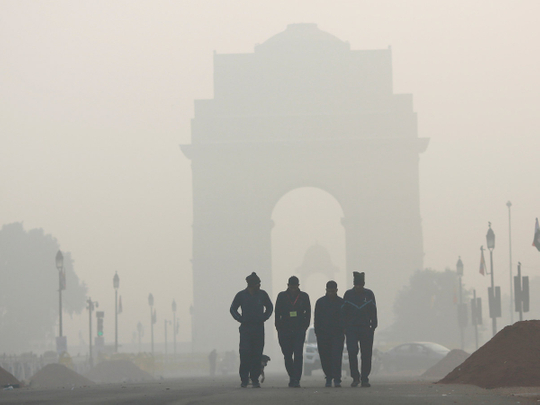
To call it a gas chamber is now cliched, the tanking of air quality in the national capital region after Diwali was on expected lines. People of the city live through this extreme shroud of smog — the kind that leads to not just the obvious symptoms of itchy eyes, headache and breathlessness but also serious respiratory long-term issues — like clockwork every year.
In fact, if you expected it differently then either you erroneously believed that we have turned a corner or that people were for once not going to flout a ban. Indians are like rebellious teens we like nothing better than breaking the rules. Only this time the disregard also came in the garb of nationalism.
Concentrations of the airborne PM2.5 particles, the fine kind that cause severe respiratory diseases hit the circuit breaker at 999- the level beyond which calculations can’t be assessed, in parts of the NCR.
24 hours after the festival, the AQI (Air Quality Index) remained the poorest in the last 5 years, this after the Delhi government had banned the sale and bursting of firecrackers. The Supreme Court though allowed green crackers during the festival but keeping a check on that is an uphill battle.
A city already on edge
Many localities reported the bursting of crackers late into the night which tripped a city already on edge. At this time of the year poisonous particles are trapped in the air and stubble burning from neighbouring Punjab and Haryana make the air noxious. 36% of the PM2.5 pollution reported the day after Diwali was caused by farm fires, but it no way gives an out for bursting crackers. The cocktail of toxins in the air we breathe don’t differentiate.
Forget Diwali, the use of crackers is not the most sensible thing to do at any time especially in the capital region- including Gurugram, Faridabad in Haryana and Noida in Uttar Pradesh, cities that consistently remain frail. There have been several red flags.
The world’s worst air pollution is in India, most reports are unanimous in this damning indictment of the country where 20 cities make it to the top 30 of the worst air- quality globally. A Lancet report says that this air kills more than a million people yearly in our country.
What should be even more concerning is the impact on children, doctors in recent years say that the number of asthmatic children in the capital has gone up. They also fear that such high pollution will hinder the brain development of the young. But mothers on social media as recent as yesterday were proudly writing about how they taught their young children to burst crackers.
Double whammy
Air pollution led to an estimated 54,000 deaths in Delhi last year, as per a study and here comes the double whammy. Covid-19 has already led to compromised lungs in Indians who were hit badly by the pandemic and Dr Randeep Guleria, AIIMS Director has warned that pollution can trigger more severe cases of the virus.
Poor air in the national capital region reduces the lifespan of its citizens by almost ten years, a three- year- old report has already warned.
But despite the writing on the wall, the ban on crackers was seen by a section of society as an affront to their cultural sentiments not realising in their indoctrination that poor health does not distinguish.
For India’s marginalised environmental concerns are understandably not a priority and Diwali comes as a respite- a rare day of celebration but what of these citizens who put up posts gloating that they had been bursting crackers for three hours and that “courts will not decide how we follow our culture?” Rationality is hard pressed even in front of life -threatening health implications. “Every cracker in the NCR had a message,” another tweeted. If even pollution can be communalised, then is there any hope?
Soon after the air quality plummeted, predictably the political blame game started. AAP blamed the BJP for encouraging people to flout the ban on crackers. Add Punjab and Haryana governments in the mix over stubble burning and it’s a show that is on repeat every year.
The intent of our politicians to genuinely and collectively solve the problem remains suspect. Whether stubble burning, industrial emissions or vehicular traffic especially by two- wheelers, long term solutions are at the mercy of vote-bank sensitivity and politicians keep faith that public memory is short. It is, but the damage is long-term and smog towers or odd-even vehicular days are merely tokenism.
A day after Diwali, Beijing also closed down after PM2.5 hit 230, levels that are normalised in across the country and despite the much higher stakes it was business as usual in the capital.
In the end, much like many issues these days, pollution is being dismissed as a ‘woke’ conspiracy of the ‘liberals.’ Poor visibility is not just associated with the air quality.
And so, we wait for the incoming strong wind, to clear the air. Unfortunately, it can’t do much about its people.





